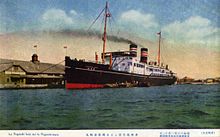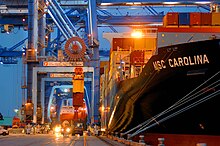
Back Redery Afrikaans خط شحن Arabic Navilier Catalan Rederi Danish Reederei German Ŝipveturiga kompanio Esperanto Empresa naviera Spanish Laivanvarustaja Finnish Compagnie maritime French Rederij Frisian


A shipping line or shipping company is a company whose line of business is ownership and operation of ships.
Shipping companies provide a method of distinguishing ships by different kinds of cargo:
- Bulk cargo is a type of special cargo that is delivered and handled in large quantities.[1]
- General cargo, now known as break-bulk cargo, refers to a wide assortment of goods that may be delivered to several ports around the world.
- Oil became a crucial part of the shipping industry in the early 20th century. Its use varied from lubrication for developed machinery, burning in boilers and industrial plants, as well as for operating engines.[1] Oil is also primarily shipped by specific shipping companies as opposed to other forms of transportation. This is considered a type of special cargo. The shipping of oil has become a debated issue due to the environmental impacts of both oil spills and oil tankers.
- Passenger cargo is the business of transporting people on shipping lines for the purposes of relocation or recreation.[2] This became a growing industry near the turn of the twentieth century with the wide use of luxury ocean liners. Passenger cargo became a logistical challenge by attempting to balance pleasure voyage aspects with the structural limitations and requirements of the vessel.[1]
- Special cargo is a term used for one specific product being shipped to a specific port.[1]
Inland shipping along rivers and other freshwater bodies are used to transport cargo to ports other than those along the coast. Inland shipping requires more infrastructure than ocean shipping. Rivers and lakes require infrastructure, such as river ports and canals, to be considered developed and ready for commercial use. Much of this infrastructure became more widely developed during the 19th and 20th centuries.[1] Some principal waterways used by shipping lines in the 20th century were the Rhine, Amazon River, Congo River, Nile River, Mississippi River, and Columbia River. Examples of waterway infrastructure include the Suez Canal and the Panama Canal.[1] These waterways are still in use for commercial purposes today. Some waterways can only operate under seasonal conditions. For example, the Great Lakes operate shipping for approximately eight months each year, but cannot continue operations during winter months when the lakes typically freeze. Most inland shipping lines are based on speed and efficiency to deliver cargo.[2]
- ^ a b c d e f Hardy, A. C. (1928). Seaways and Seatrade. New York, NY: D. Van Nostrand Company.[page needed]
- ^ a b Rodrigue, J. P. (2017). “Maritime Transportation”. The Geography of Transport Systems. New York, NY: Routledge. Retrieved from https://transportgeography.org/?page_id=1762